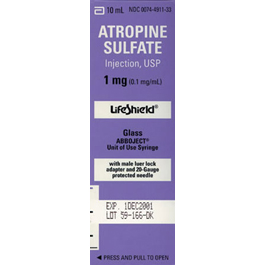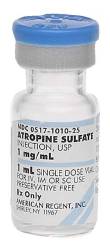Virtual Drug Bag
|
ATROPINE |
 |
  |
PACKAGED:
1mg in 10ml prefilled syringe; (3 in drug bag)
1 mg in 1 ml vial; (HM bag in drug bags)
2 mg AtroPen autoinjector; (in Chempack, Drug Caches and HM bag in drug bags)
1 mg AtroPen autoinjector (in Chempack, Drug Caches and HM bag in drug bags)
0.5 mg AtroPen autoinjector (in Chempack, Drug Caches and HM bag in drug bags)
Multidose vial 8 mg in 20 ml, 0.4 mg/ml; (in Chempack)
Duodote: Autoinjector Atropine 2 mg and 2-Pam 600 mg
NOTE: Atropine is also one component of the Mark 1 kits or as a Duodote (in with the HazMat Drugs in GMVEMSC Drug Bags).
LOCATION: Main Compartment
INDICATIONS:
Symptomatic bradycardia, asystole, PEA with slow rate
Organophosphate or Nerve Agent poisoning (regardless of cardiac rate)
ADULT:
Bradycardia: 0.5 mg IV up to 3 mg
Asystole, PEA with bradycardia: 1 mg, IV/IO
For asystole or slow PEA (repeat every 5 minutes up to 3 doses)
Organophosphate or Nerve Gas poisoning: 2 mg IV, IO or IM every 5 min OR Mark 1 Kit item one, or Duodote until lungs are clear to auscultation. There is no max dose for Atropine for Organophosphate or Nerve Agent poisoning.
PEDI:
Bradycardia: 0.02 mg/kg IV/IO (minimum single dose of 0.1 mg, max single dose 0.5 mg) every 5 min. Max total dose 1 mg
Organophosphate or Nerve Gas poisoning: Atropine or (AtroPen) autoinjector
<40 lbs: 0.5 mg Atropine, IV, IM or (AtroPen) Autoinjector
40 lbs to 90 lbs: 1.0 mg Atropine, IV, IM or (AtroPen) Autoinjector
> 90 lbs: 2.0 mg Atropine, IV, IM or (AtroPen) Autoinjector
There is no max dose for Atropine for Organophosphate or Nerve Agent poisoning.
THERAPEUTIC ACTION:
Anticholinergic
CONTRAINDICATIONS:
None for severe organophosphate exposure.
Tachycardia, hypersensitivity to atropine, obstructive disease of GI tract, obstructive neuropathy, unstable cardiovascular status in acute hemorrhage with myocardial ischemia, narrow angle glaucoma, thyrotoxicosis
PRECAUTIONS AND SIDE EFFECTS:
Tachycardia, paradoxical bradycardia when pushed too slowly or when used at doses less than 0.5 mg, palpitations, dysrhythmias, headache, dizziness, anticholinergic effects (dry mouth, nose, skin, photophobia, blurred vision, urinary retention, constipation), nausea, vomiting, flushed, hot, dry skin, allergic reactions. Atropine causes papillary dilation rendering the pupils nonreactive. Pupil response may not be useful in monitoring CNS status.
REQUIRES MCP:
ADULT:
Bradycardia, Asystole / PEA—No
Organophosphate Nerve Agent Poisoning—Yes
PEDI:
Brady—No
Organophosphate Nerve Agent Poisoning—Yes

